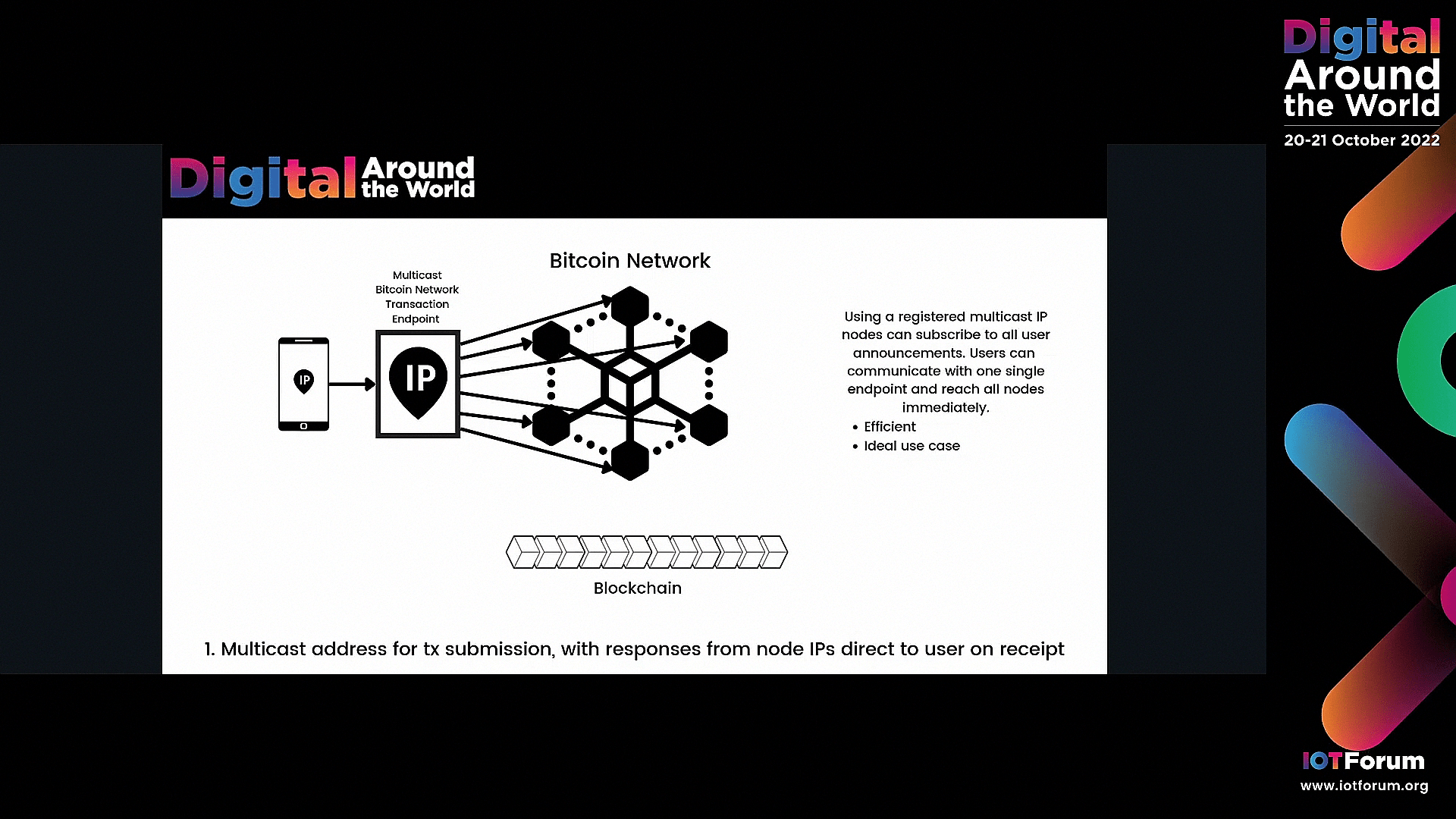Bitcoin with billions of secure transactions per second, with IPv6 multicasting

There is much more to IPv6 and Bitcoin than “lots of new IP addresses”. We’ve heard about P2P transactions and communications, and we’ve heard about improved security. But how is all this achieved? In a recent webinar for the Digital Around the World event, Bitcoin creator Dr. Craig S. Wright went into the details with IPv6 Forum Chair Professor Latif Ladid, Elas CEO Brendan Lee and nChain Research Director Dr. Owen Vaughan. The goal is to introduce these new concepts to external developers, who can then harness the BSV blockchain’s “superpowers” to start building tools for a better and more secure internet.
All the complete sessions from Digital Around the World 2022 are now available on the event’s website. This particular discussion has the somewhat mundane title of “IPv6-Based Blockchain”, although the content is anything but ordinary.
Some of the concepts described in IPv6 and Bitcoin are complicated and full of technical jargon. This may be necessary to present the ideas at these early stages, and Dr. Wright calls for processes and descriptions to be easier to understand, something nChain is also working on.
“What you’re talking about is empowering the end users, which is fundamental,” notes Professor Ladid.
Bitcoin has been this way since its inception
Bitcoin was designed as an electronic cash system with the ability to send payments directly from one party to another. Dr. Wright puts it simply: this means “directly” – Alice doesn’t pay Bob by sending information to a mesh server; she sends it directly to Bob. Bob records the transaction on the ledger (ie the blockchain) via Bitcoin’s “small world” network, which timestamps it. He also notes the reasons why Simplified Payment Verification (SPV) is needed to streamline this process: a recipient (Bob) must be able to check that the transaction is valid by checking only block headers, not the entire Bitcoin blockchain.
Currently, most receivers will check if a transaction is valid by searching the entire network for the details (difficult and inefficient). With SPV, the sender (Alice) can “deliver the transaction” directly to the recipient (Bob), who immediately knows that it is valid.
What does this have to do with IPv6?
“IPv6 has a lot of functionality that improves the operation of P2P networks,” says Dr. Wright. This is the Internet’s original promise of direct communication.
IPv6’s “multicast address” capabilities (remember that term) play a big role here. Nodes register as part of the network, allowing everyone to receive transactions at the same time. Bob does not need to broadcast the transaction to all nodes; he only needs a single message to the network. Likewise, transaction processors (miners) do not need to broadcast it to every machine after solving a block. The same single message to a multicast group will do that.

This increased inefficiency will allow Bitcoin SV (BSV) to massively scale to millions of transactions per second by next year and potentially billions or tens of billions per second by the end of this decade.
Better cyber security models on open networks
An exponentially increasing number of devices will connect to the internet at ever lower costs per device, including $10 tablets and IoT sensors at the lower end. DNSSec in IPv6, combined with blockchain records, also means new and better cyber security models than today’s shell firewall and authorized certificate techniques. Dr. Wright mentions that nChain is developing concepts using broadcast and reversible encryption that can produce “an encrypted file that is provably owned (only) once” and is impossible to copy.

“Transactions are going to be very different in the future,” he adds, with different transaction formats containing information embedded in their headers and data to indicate (for example) payments and charges, configurations, firewall policies, security features, access and NAP policies, etc. .with interactive and up-to-date communication – all based on what individual users use.
“Decentralization doesn’t mean people running around saying ‘the government can’t stop us’, it means moving machines to the edges of the network. The promise of the internet was supposed to be 20-30 years ago.”
That means owning information and proving you own it without it going through “Silicon Valley hubs” (one of Dr. Wright’s most famous nemeses), whether it’s cash/payments, your private data, classified documents, business contracts and more more. The Bitcoin blockchain records all this information and makes it publicly validable without revealing the information itself. You can always enforce ownership and see if someone is trying to cheat the system.
Bitcoin is just the technology that sets the base layer for all of this. It is not intended to determine policies and laws that define ownership, just as it does not determine whether a document is classified or not. Humans ultimately set and enforce these rules, while Bitcoin enables efficient operations.
Why this must happen on an open blockchain
All this can happen on an open and publicly accessible network. In fact, these are the features that keep the system more honest, while so-called “private blockchains” lack the ability for anyone to audit the records. Essentially, private blockchains are just more closed systems where you have to trust the operator to do the right thing.
We need to think about creating different models for these networks, continues Dr. Wright. Just as today’s cash/digital transaction systems treat the purchase of a coffee and the purchase of a car differently, so too will these models for different types of data transfer/transactions. IPv6 features allow devices at the edges of the network to communicate directly (securely) with each other at scale.
All in all, giving people the scaling solutions to build new and innovative tools for Bitcoin will enable the development of new applications in data management. These will go far beyond the original scope of “digital cash.” Dr Wright also describes how the more secure Proof of Work (PoW) Bitcoin network becomes more energy efficient as it adds more users – energy consumption remains the same whether it is 100 transactions per second or a billion.
Develop P2P/end-to-end applications
Other speakers in this webinar go into more technical details about IPv6, using multicast addresses to submit transactions, and how their companies are working to make end-to-end communications a reality.
Ela’s CEO Brendan Lee echoes Dr. Wright’s message that ordinary users get their communications into the deeper parts of Bitcoin’s small-world network as quickly as possible. Instead of user apps (or miners’ machines) connecting and sending message copies to multiple nodes, IPv6’s multicast address groups cut this down to one, moving the heavy lifting of propagation to deeper layers of the network.

He describes how peers on the network can be coded to connect and negotiate to establish shared multicast addresses (mentions CGA and Diffie-Hellman secret sharing). Different levels of communication are handled by parts of the network (both hardware and software) that are optimized to perform each task. It’s an environment “where every millisecond counts.” Theoretically, he says, it’s possible to even have multisig addresses that require millions of keys to complete a transaction instead of the usual small group.
nChain Research Director Dr. Owen Vaughan gives a “more fundamental talk” on the differences between “data packets” and blockchain transactions, user-to-user payments, and IPv6 addresses versus “payment addresses.” It is interesting to note that the format of Bitcoin transactions, first designed by Satoshi Nakamoto in the late 00s, looks quite similar to IPv6 headers, he says.
He also describes some key differences between Unspent Transaction Output (UTXO)-based blockchain models (like Bitcoin) and “account-based” blockchain models (like Ethereum). UTXOs are independent of each other and can be processed in parallel, whereas the account-based model must process them sequentially.
He says previous services, including BIPs (Bitcoin Improvement Proposals), reflect the needs of small-scale blockchains and account-based models. IPv6 will allow things like direct billing, verifiable identities (where desired)
The conversation around IPv6 and Bitcoin is still very much at the conceptual stage. Continuing to educate developers and users about their features and benefits will mean more useful (and far easier to understand) tools in the future. In the end, end users probably won’t even notice and, like Bitcoin itself, blend into the background like “plumbing”. But the end result will be a better, faster and more honest internet.
Watch: Dr. Craig Wright’s Keynote: A Better Internet with IPv6 and BSV Blockchain at the BSV Global Blockchain Convention
width=”562″ height=”315″ frameborder=”0″ allowfullscreen=”allowfullscreen”>
New to Bitcoin? Check out CoinGeeks Bitcoin for beginners section, the ultimate resource guide for learning more about Bitcoin – as originally envisioned by Satoshi Nakamoto – and blockchain.

























